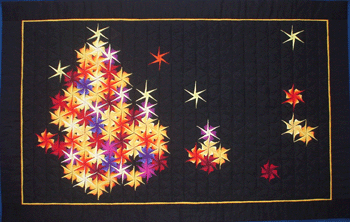| Creating the Icicle Quilt My first notes for the Icicle quilt say, "Something with crystal type structure, triangles, diamonds, stars. Sparkling. Icy blues with white." I liked Judy B. Dales quilt, "Stellar Transformations", or Shawn Walker Levy's, "What Star is this?", both of which I'd seen in Joen Wolfrom's book, THE VISUAL DANCE, published by C&T Publications. The crystalline forms in quilt on the cover of that book, "Feuerfacetten mit 2 Papageien" by Erika Odemer, were also inspiring, though not the palette I needed. But then I designed the Solstice quilt and got intrigued with those starry triangles. It would be fun to take the same pieces and make two very different quilts. |
All images and text © Anna Grossnickle Hines 2005
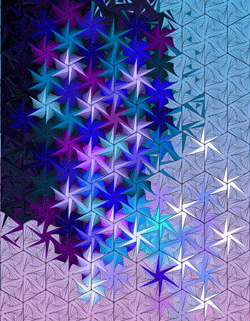
|
I used the Solstice hexagons, made with six triangles, filled the spaces with icicle colors and "built" my icicle. |
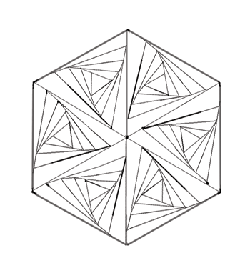
|
While the Solstice quilt had a solid black background, this one needed a sky that could go from night to day. To give me a clue what that would be like I put a gradient fill behind the lines and filled stars, then tried to fill to match it. |
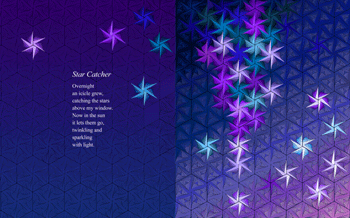
|
The editors were concerned that there was no sunlight in my design--a good point-- and also asked that I add a frame. The yellow adds a spark it didn't have before. |
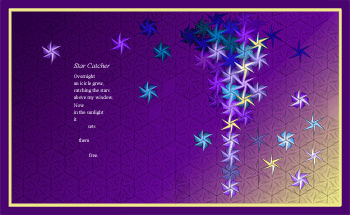
|
The gradient won't work with fabrics though. I need a defined number of colors so I replace the gradient with bands of color from very dark purple to sunny yellow. Then I begin mixing the colors along the edges to blend them. I like the way they kind of "twinkle". |
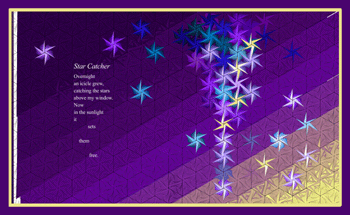
|
After some tedious time with the fill tool in PhotoShop the whole thing is blended. I begin to think it's possible...if I can find the right colors! Going smoothly from yellow through the rosy shades of dawn to the purple of night is tricky. I choose the best of the fabrics in my stash and take them to a meeting of my illustrators group at the San Francisco Library. They help me see that where my colors jump too much from one to the next, it's because a couple of the fabric colors are too intense. I go shopping to replace them with shades of color that are toned down a bit. |
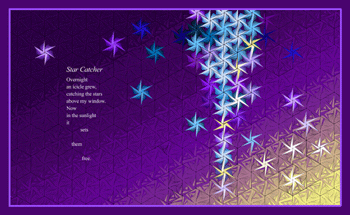
|
This is my final selection of thirteen colors for the background... |
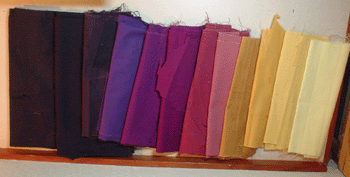
|
...and a selection of colors, arranged into sets, for the icicle stars. |
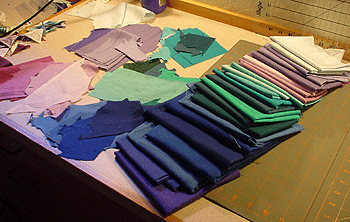
|
I print out my design, small in bright colors, and a muted version where I can see the lines and chart my progress by marking triangles off as I go. |
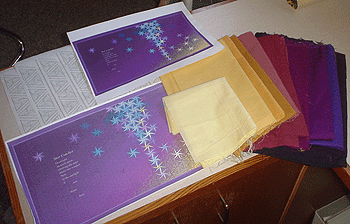
|
I've also printed my triangles on sheets of Fundation™. I cut them apart and I'm ready to sew. |
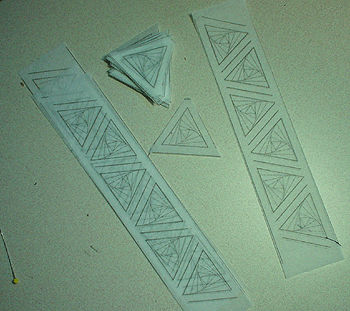
|
I sewed a few rows before I realized that I hadn't thought my background colors and fabrics through carefully enough. I wasn't clear exactly which ones I should be using where. |
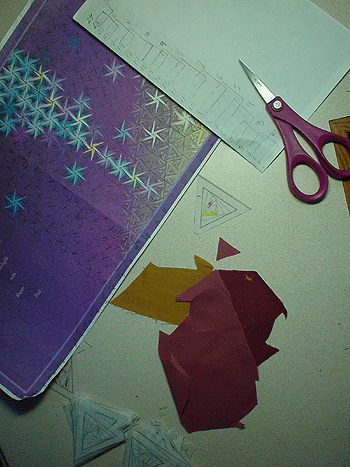
|
I mark each foundation piece with a fabric marker as I go. The exact placement of the each bit of background color within the triangle isn't critical, but getting the right mix is. The marked piece here will be half the lighter color and half the darker. |
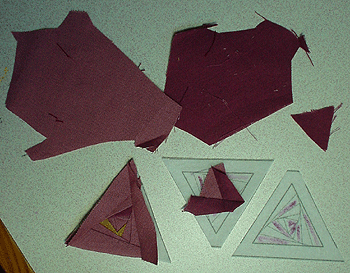
|
I begin with pieces of fabric about 4 by 9 inches, small enough to be manageable, but large enough that I don't waste too much. I sew, then fold out and trim each piece. |
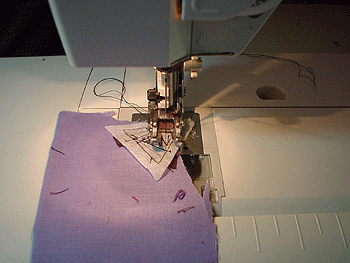
|
Here I've put small pieces of the red-purple and dark-purple into the two mostly blue- purple triangles (one band), then two triangles that are half and half blue and dark purples (the next band), then mostly dark with a little bit of blue-purple and a spot of the next darker color (another band). The light blue is part of a star. |
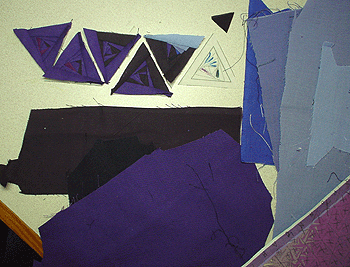
|
My publisher was waiting for me to finish this last quilt, so I had to work as quickly as possible. I couldn't stitch the triangles together without basting, which was time consuming, so I'd pin them in pairs as I completed them, set them aside, and go on to sew the next pair. In the evenings when I was too tired to sit at the sewing machine, I'd baste my pairs. The next morning I'd stitch and press those pairs, then go on to making new triangles. |
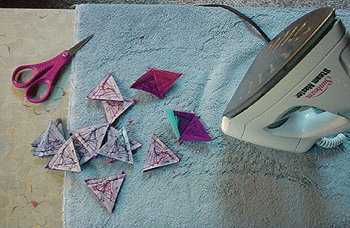
|
The next evening, along with basting the new pairs for the day, I'd baste the stitched pairs into rows. |
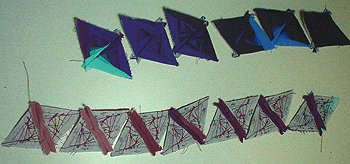
|
When I had a row done, I'd pin it to the quilt with a pin straight through the matching points of the triangles. The work was too thick to tuck the pins in and out in the usual way. Then I'd baste carefully, making sure the needle was staying on the line of the foundation pieces on both sides. It took me about an hour and a half to baste each strip onto the quilt. Once it was basted the stitching went quickly. |
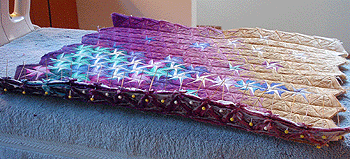
|
Once I'd made my chart to guide me in getting the sky colors to transition smoothly, and sewn enough rows to see how well it worked, I knew I had to go back and redo the part I'd done first. I'd started with the longest part of the icicle. At the top there wasn't enough sky showing to make much difference, but at the bottom it wasn't working well. |
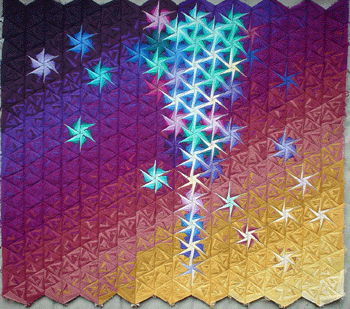
|
So I took it apart and redid it to make that area blend better. |
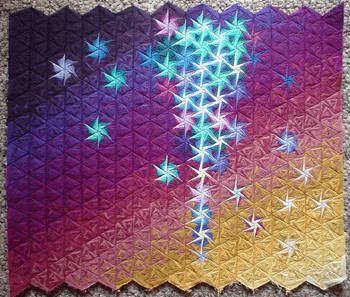
|
In this closer view you can see how I've used each sky color as the main color in one pair (in both the row and on the diagonal band), half and half in the pairs above and below it, with a spot or two in the pairs above and below those. It took a quarter of a yard of each fabric to do 10 or eleven rows in the quilt. I knew right away I was going to run out of one fabric, which I was able to get by mail from ThimbleCreek. Toward the end I knew I needed two more, one of which I wanted to use in the border. Fortunately they still had both of those as well. |
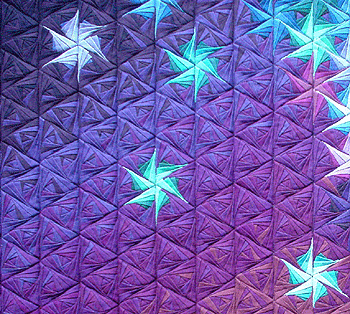
|
I used the same method to add body to the border as I had on the Solstice, Candle, and Fireplace quilts. I won't describe it again here, but couldn't resist putting in a picture of my freehand quilting which is hidden inside-- never to be seen by anyone. (Why is it easy when you don't care what it looks like?) |
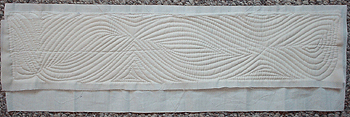
|
This is the back of the quilt with the added quilted borders, ready to be trimmed and covered with the border fabric. |
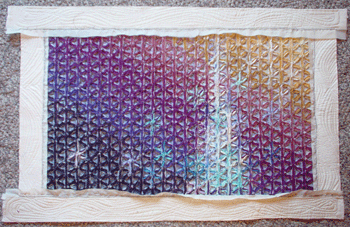
|
I worked on this quilt for part or all of 54 days in June, July and August of 2004, a total of about 400 hours. And I was so happy to be finished with all the quilts! |
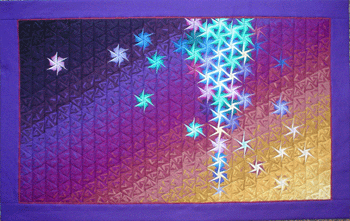
|
Like Solstice, Icicle has 650 triangles, each one with 13 pieces, for a total of 8450 triangles. The arrangement of triangles is the same, but don't they look different? |
